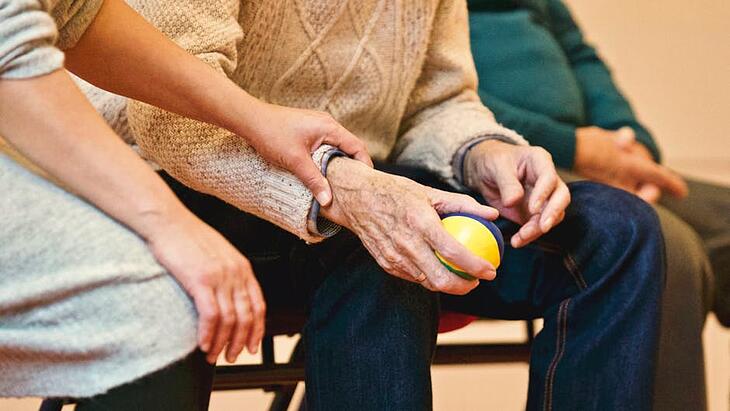If you’re an arthritis sufferer, you live with constant pain – pain that keeps you up, holds you back and impacts your life on a daily, minute-by-minute basis.
Though certain medications can help manage the pain, they don’t ease it entirely, and arthritis remains a constant burden on your body, mind and soul.
How can you lessen that burden and make living with arthritis easier? More importantly, how can you lead the life you want to lead – whether you have arthritis or not?
According to real-life arthritis sufferers just like you, these exercises, activities and dietary choices can help.
Exercises
Staying active is crucial to managing arthritis – but for most people, it only greatens the pain. The key is to focus on low-impact exercises that don’t put pressure on the joints. Some good examples include:
- Stationary biking
- Swimming
- Water aerobics
- Yoga
- Walking
Avoid weight-bearing exercises like running, using an elliptical or doing any sort of jumping or dancing. These can add further stress to your already embattled joints.
It’s also important to avoid remaining stagnant for too long. If you’re working at your desk, make sure to get up every 15 or 20 minutes to stretch, walk around and move your joints. The same goes if you’re watching TV, reading a book or just relaxing with a cup of coffee. Keep moving throughout the day to keep joints loose.

Dietary Choices
Just 10 or 15 pounds extra can put immense weight on your joints and cause arthritis pain to worsen, so keeping your waistline in check is vital to managing your disease.
Though “dieting” isn’t necessary, per se, try to focus on providing your body with good nutrients, vitamins and minerals. This means lots of whole grains, lean proteins and plenty of fresh fruit and vegetables.
Other dietary recommendations include:
- Eating more fatty acids – Increasing your fatty acids can also help ease arthritis pain. You can get this through fish oil supplements or by eating plenty of fish and seafood in your diet.
- Add turmeric – Turmeric, a yellow spice often seen in Indian and Mediterranean foods, has anti-inflammatory properties that can provide arthritis relief. You can use turmeric to season meats, add it to rice or vegetables, or even stir it into a warm cup of milk or tea to drink.
- Consume more nuts and seeds – Nuts and seeds have been shown to reduce inflammation and swelling – but make sure to eat them in moderation. Add a handful to your salad for lunch, or grab a small bowl for an afternoon snacks. Sunflower seeds, chia seeds, cashews, almonds and walnuts are all great choices.
- Cook in olive oil – Stay away from cooking in butter or canola oil, and switch to olive oil instead. Loaded with anti-inflammatory properties, it can cut down on the swelling and aching in arthritic joints. Just make sure to choose a quality brand that hasn’t been refined or over-processed, and stick to extra virgin varieties.
- Enjoy more beans – Beans have fiber, antioxidants and anti-inflammatory properties and can be great for arthritis sufferers. Look to red beans, kidney beans and pinto beans first, as these have the highest levels of antioxidants.
Gluten, as well as more refined grains, have been shown to increase inflammation in some people, so try focusing on whole grains and gluten-free options like quinoa, rice flour and oatmeal. Opt for whole wheat bread over white bread whenever possible.
Other Activities
Keeping your weight down, eating healthy and staying active are all solid pathways to managing your arthritis and the pain it brings you. Some sufferers have also seen relief with alternative therapies and activities like:
- Hot and cold therapy – Alternating between hot and cold therapy can be great for arthritic joints. Things like heating pads, electric blankets or even warm baths can relieve stiffness in the joints, while cold treatments like ice packs help alleviate pain, inflammation and associated swelling.
- Acupuncture – Though not a true medical science, acupuncture has been used for centuries to treat all kinds of diseases and pains – and many people swear by its efficacy. The treatment involves inserting small needles into key points on the body to increase blood flow. Make sure to ask your doctor before seeking acupuncture.
- Meditation – Arthritis and the pain associated with it can often cause significant mental stress – which can increase inflammation and worsen your condition overall. Meditation exercises and mindfulness have been shown to lessen this sort of stress and improve your mindset.
- Massage – Regularly massaging your aching joints can help lessen pain and ease stiffness. Try seeing a professional massage therapist on a regular basis, or find a physical therapist who can walk you through self-massage tactics you can use at home.
- Focusing on the strongest joints – Rely on your stronger muscles and joints to alleviate pain on those most arthritic. Open doors by pushing them with your arm or elbow, and keep your wrists and fingers from additional stress. Lead with your stronger leg going up or down stairs, and use a walker to alleviate stress on your ankles or feet. Do what you can to utilize your stronger, less pained muscles and ease the burden on the rest.
- Seeing a chiropractor – Chiropractic care has been shown to help with certain arthritic conditions, particularly those of the back, hips and neck. See a professional chiropractor for full evaluation – and always speak to your primary care doctor before seeking new treatment.
Making certain modifications to your home can also help ease arthritis pain. Adding a ramp can make it easier to get in and out, and putting grab bars on the tub or walls can give you somewhere to balance and ease weight off your hips while moving about your house.
Moving to a professional care facility is also a great way to get the help you need, while also being surrounded by a loving, caring community of your peers. Come tour Ganton’s Countryside today to see for yourself.
For information about Countryside, call Margaret Nagel at (517) 206-5000 or download our brochure to learn about our care levels, cost, and amenities.


